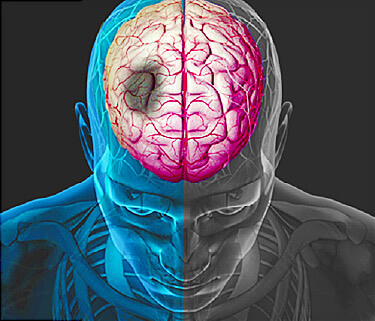
Strokes and Transient Ischemic Attacks (TIA) are caused by a rupture of a blood vessel (hemorrhagic stroke) or thromboembolism (ischemic stroke) in the Circle of Willis (blood supply for the brain). This occlusion or rupture ultimately leads to a lack of blood and subsequently reduces the amount of oxygen reaching the tissue distally to the pathology, leading to hypoxia, ischemia and cell death in the case of a stroke. This hypoxia leads to dysfunction of nerves in the affected area of the brain which can result in limb paresis, facial droop, slurring of speech and many other symptoms.
 The underlying trigger of a stroke/TIA is usually hypertension (high blood pressure), atrial fibrillation (irregularly irregular heart rhythm) or a connective tissue disorder that has led to weakness in the blood vessel walls (endothelium).
The underlying trigger of a stroke/TIA is usually hypertension (high blood pressure), atrial fibrillation (irregularly irregular heart rhythm) or a connective tissue disorder that has led to weakness in the blood vessel walls (endothelium).
Assessment:
Use the FALE mnemonic.
FACE: Is their face symmetrical? Is their tongue out straight? Is their uvula deviated? Is their speech slurred?
ARMS: Test for power, coordination and sensation.
LEGS: Test for power, coordination and sensation.
EMERGENCY: If the patient fails any of these tests, it is a medical emergency. Call 000!
Management:
Management of a stroke depends on the underlying mechanism. For thrombotic/embolic strokes, the patient should initially be assessed as a candidate for intra-arterial thrombectomy (clot retrieval). Ideally, this procedure would need to be performed within 90 minutes of symptom/s onset, in order to achieve optimal outcome. Where thrombectomy is not available or time restraints are not met, thrombolysis is recommended within 4.5 hours. This is a medication which aims to break down the existing clot and restore blood flow to the brain. There are a number of contraindications to giving a patient thrombolysis which MUST be considered as this could cause more harm than good.
Impact of Management:
The impact of management has the potential to completely resolve the patient’s symptoms leaving them in the same health as they were prior to the stroke. This will only occur If the CORRECT management is undertaken and it is done so in a timely fashion. As with all medical treatments, there are some risks associated with both thrombectomy and thrombolysis which the patient (or the decision maker) must understand prior to undertaking the treatment. It also needs to be considered that the treatment may be unsuccessful and the symptoms that they initially presented with, may not be resolved by the management, despite the risks that were taken.
